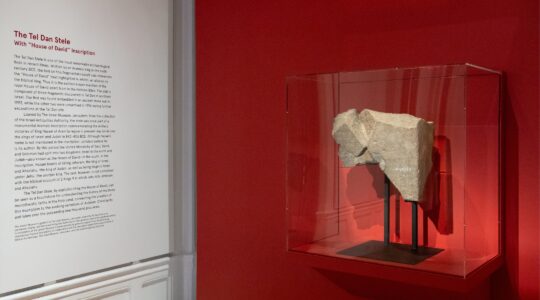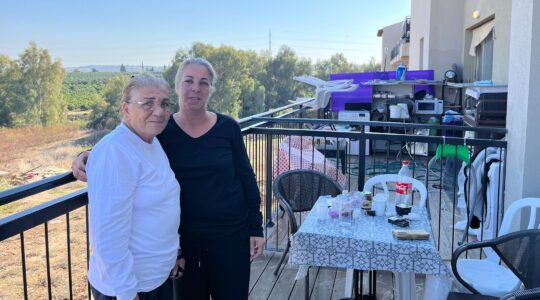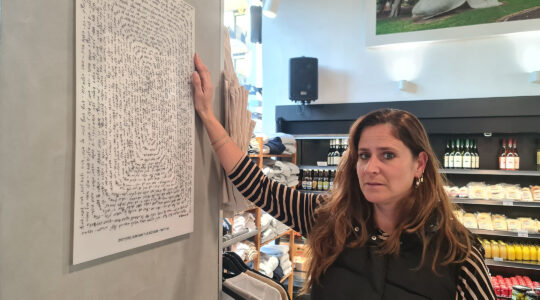TEL AVIV (JTA) – It’s been a long journey for the brittle pieces of parchment inked more than 1,000 years ago along the shores of the Sea of Galilee.
The manuscript considered the most authoritative text of the Bible, the Aleppo Codex, was studied by Maimonides, ransomed by Crusaders and dismembered during rioting in the Syrian city of Aleppo.
A tiny patch of the codex even spent several decades in the wallet of a businessman from Brooklyn, N.Y. – Sam Sabbagh revered it as an amulet with sacred powers.
Several weeks ago that fragment was brought to Israel, prompting a new drive for the return of the text’s other long missing pieces.
“Our feeling is that if there is one piece of it, there must be others,” said Michael Glatzer, academic secretary of the Yad Ben-Zvi Institute in Jerusalem, which has worked to track and study the codex.
Last week, the institute launched a new campaign to bring other missing pieces of the famous codex home to the Holy Land.
“There must have been other fragments held by people today who might not even know that it is the Aleppo Codex, who don’t know this is the most important manuscript of the Bible,” Glatzer said. “We are trying to reach out to Jews from Aleppo who live all around the world to see if they have [pieces] and if they will come forward.
“We would like to contact anybody who thinks they might have a piece of the codex. We are very eager to put this puzzle back together,” he said.
About 60 percent of the manuscript is in Israel.
It was smuggled in from Syria by a Jewish family in 1958, but more than a third of it remains incomplete. Originally it was assumed that the remainder was burned during the anti-Jewish riots that broke out in Aleppo in 1947 following the United Nations vote in favor of partitioning Palestine.
But an additional page presented by a Syrian Jewish family in the 1980s and recent forensic testing on the part of the manuscript that is in Israel found that the codex was not burned. That fueled speculation that other pieces may yet be found.
“We are like detectives trying to hunt down these missing pages,” said Yosef Ofer, a professor in Bar-Ilan University’s Bible department and an expert on the text.
“Some of it did possibly burn or could have been stolen,” Ofer said. “Other parts could be with people, but so many years have passed that it might be in the hands of the second or third generation who do not realize what they have in their hands.”
Glatzer told JTA the institute is negotiating with several former members of the Aleppo community in the hopes of retrieving at least part of the remaining codex. He would not give any further details about the discussions for fear of disrupting progress.
The Jews of Aleppo, who trace their origins in the city to the period following the destruction of the Second Temple in the year 70, saw the codex as something holy in itself – a relic that protected them. They viewed themselves as its custodians, believing that if any harm came to it their community also would be in danger.
Indeed, it was soon after the synagogue that housed the codex was set ablaze in the 1947 riots that the Aleppo community fled to cities across the world.
“It had an aura of sanctity beyond scholarly value. They were protective of it,” Glatzer said of the codex, which is also known as the Masoretic Text.
It is thought that the 10th century text was written by a scribe named Shlomo ben Buya’a in Tiberias around 920. It was then vocalized and edited by Aaron Ben Asher, a renowned grammarian and scholar.
From Tiberias it was brought to Jerusalem. After it was stolen by Crusaders, it was somehow bought back by the Jewish community of Cairo. It was there that Maimonides used it as the authoritative version of the Bible on which he based his famous commentary.
Sabbagh, the Brooklyn businessman, found his small piece of the codex on the floor of the Aleppo synagogue after the 1947 riots. For years he kept it in his wallet, refusing to part with it. He even kept it with him during open heart surgery.
It took several years of negotiation after his death in 2000 for his family to agree to bring the scrap of the codex to Israel.
The Jews of Aleppo, who had a rich history as a community of scholars and successful traders, remain a tightly knit community even in the exile they have endured since fleeing Syria in the face of anti-Jewish persecution following Israel’s establishment.
Aleppo’s Jews have since established new communities in Israel, Brooklyn and Deal, N.J., as well as the South American cities of Buenos Aires and Sao Paulo.
The portions of the codex that have been retrieved are housed in the Shrine of the Book at the Israel Museum in Jerusalem, where the Dead Sea Scrolls are located.
The newest addition, the fragment carried in Sabbagh’s wallet, soon will be included in the display.
In small but still legible Hebrew letters, it contains a few lines of verse from the Book of Exodus. Among them are the words Moses said to Pharaoh: “Let my people go, that they may serve me.”
Israeli scholars are hoping the quest to retrieve the remainder of the codex will help the Jewish people.
“This is the No. 1 asset of the Jewish people,” Zvi Zameret, the director of Yad Ben-Zvi Institute, said at a news conference. “And I believe the Jewish people would do a great deal to have it back.”
JTA has documented Jewish history in real-time for over a century. Keep our journalism strong by joining us in supporting independent, award-winning reporting.





